Alternative sightseeing in Abu Dhabi
Even though it is the United Arab Emirate of Dubai that is known for its innovative architecture, it was the far less brash UAE capital, Abu Dhabi, that stole the show for us. Like Dubai, the city has many contemporary structures that are well worth discovering (which we did) but we were predominantly interested in its original modernist architecture that dates back to the 1970s and ‘80s.
Not surprisingly, Abu Dhabi’s original urban modernisation is linked to the discovery of oil in the late 1950s. At the behest of the then ruler of Abu Dhabi, Sheikh Zayed, a Japanese urban planner and architect called Katsuhiko Takahashi was invited to create the first blueprint for a modern version of the Emirati capital (*). He was replaced in the mid-1970s by an Egyptian city planner, Dr Abdulrahman Makhlouf. Makhlouf continued with Takahashi’s original masterplan but also added Arabian influence.
(*) Reportedly, Takahashi sketched out his initial idea for the city in the sand using a camel stick.
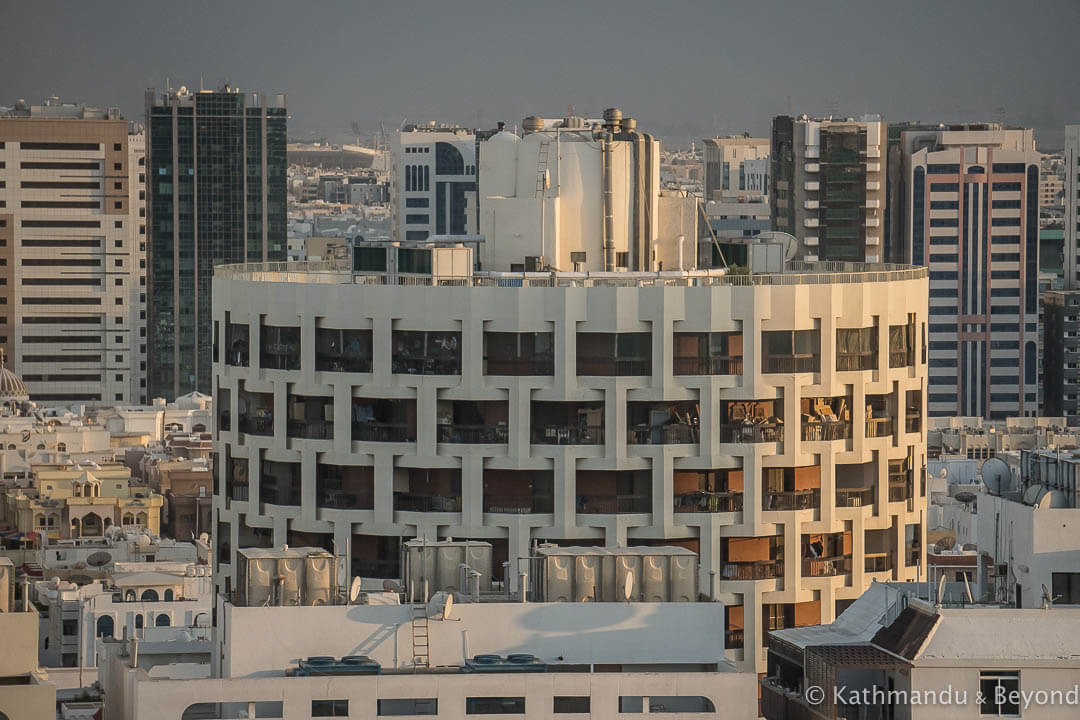
Al-Ibrahimi Building punching through downtown Abu Dhabi’s skyline
Finding anything that dates back to the 1960s in Abu Dhabi is difficult. Most of it has been demolished. There is also a question mark over how long the city’s buildings from the 1970s and ‘80s might last. In one camp you have architecture and heritage enthusiasts who, rightly in my opinion, see this era of architecture as an important part of the city’s history. But, in the other camp, you have those who attach no cultural importance to these structures, arguing that they were poorly built (*) and should be knocked down and replaced with something newer and/or more practical.
(*) There is truth in this statement. Due to a shortage of freshwater in the region, saltwater from the Persian Gulf was used to mix concrete and we all know what a corroding element salt can be. As an example, some of the city’s late 1970s buildings only survived until the 1990s before it became necessary to knock them down.
We experienced similar challenges when we searched for architecture from the socialist-era in both the former Soviet Union and the Eastern Bloc. To an extent, I can understand it more in these parts of the world: there is less urban space and therefore more of an argument to demolish and start again. There is also the social comment that many of the structures in former communist countries have a connection to a past that would rather be forgotten. But this is not the case in Abu Dhabi, or elsewhere in the UAE for that matter. With regards to issues with space, we were fortunate enough to stay with a good friend in Abu Dhabi and he drove us all over the place. We saw a lot of space on the outskirts of the city and even large areas of undeveloped land not that far from what you could call downtown.
Personally, we were too late to see the curved 1970s residential buildings that belonged to the Abu Dhabi National Oil Company (ADNOC), which will be mentioned later in this post. Part of the complex was demolished in 2004 to make way for a new masterplan that ADNOC had for their headquarters but we were under the impression that at least one of the buildings was still there. But it wasn’t when we visited in November 2019 and, according to a security guard we spoke to, the remaining structure(s) had only recently been knocked down.
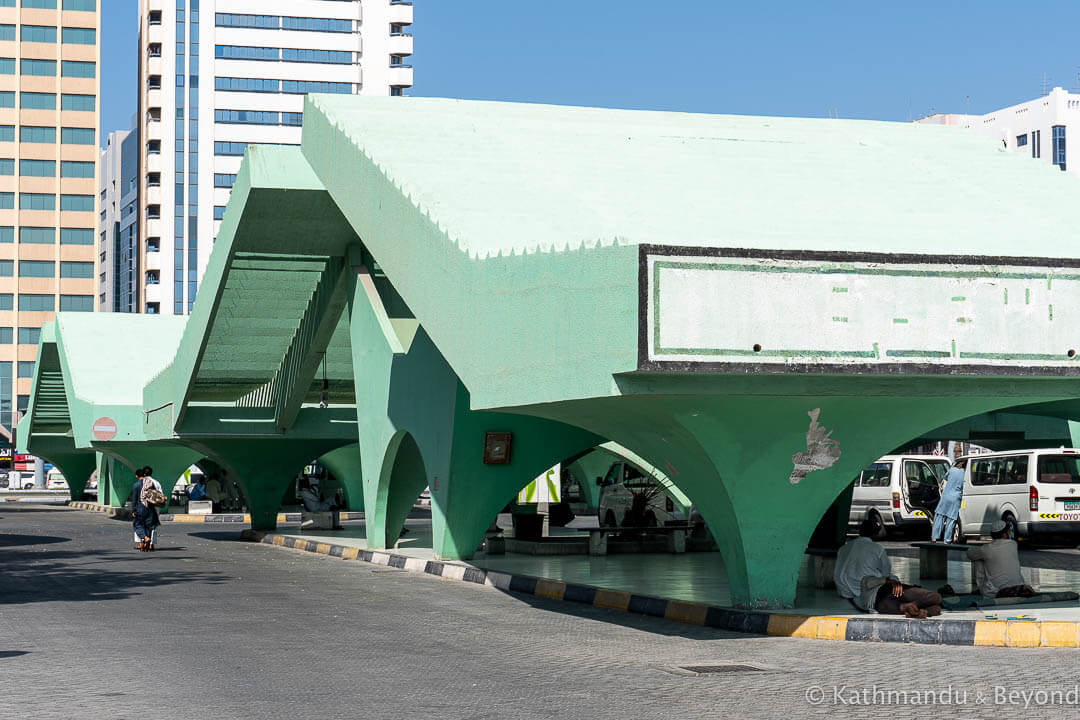
Taxi stand at Abu Dhabi Central Bus Station
Abu Dhabi Vegetable Market was another disappointment for us. Still very much in situ, it was being painted in various shades of bright colours when we went to view it and it looked awful. But at least we got to see the curvaceous taxi stand attached to the city’s glorious bus station. We were at a social gathering at one of the city’s flash hotels (I can’t remember which one) a few days after visiting the depot and I got talking to a Frenchman who seemed to know what he was talking about when it came to architectural heritage in Abu Dhabi. He informed me that the taxi stand was slated for demolition. I have no proof of his statement, however.
There is some good news. The Modern Heritage Preservation Initiative was launched by the Abu Dhabi Authority for Culture and Heritage (ADACH) in 2011. As this article in the Middle East news outlet, The National, explains, the organisation, which was replaced by the Abu Dhabi Tourism and Culture Authority (TCA Abu Dhabi) in 2012, tries to act as a middleman between the preservationists and the developers when the fate of one of these buildings is questioned. Their cause was further given weight by the introduction of the Cultural Heritage Law in 2016, which considered “modern heritage on par with archaeological and historical sites.”
In the case of the ADNOC residential buildings, organisation’s sway clearly wasn’t powerful enough, even with the Cultural Heritage Law in place, and I suspect that sprucing up the vegetable market with a paint job was probably a compromise of sorts. If indeed the taxi stand mentioned above is due for the chopping block, it will be interesting to see who comes out on top.
Just as I was about to finish this blog, I found another article in The National. This one is connected to a public awareness campaign recently launched (April 2020) by the Department of Culture and Tourism – Abu Dhabi that connects next year’s (2021) 50th anniversary of the founding of the UAE with the importance of its modern heritage, which includes the preservation of the city’s modernist architecture. If it is effective, the campaign could be good news for Abu Dhabi’s original modernist buildings, especially as there is talk of providing funds to maintain those that have been neglected over the years.
I’ve got one final point of interest before moving on to the architecture itself. All of the architects of Abu Dhabi’s early modernist structures were foreign, with Egyptian, British, French, American and Bulgarian participants. The Bulgarian influence may explain why there is familiarity between some of Abu Dhabi’s prominent modernist architecture and many of the buildings that were constructed in the Eastern Bloc during the same period.
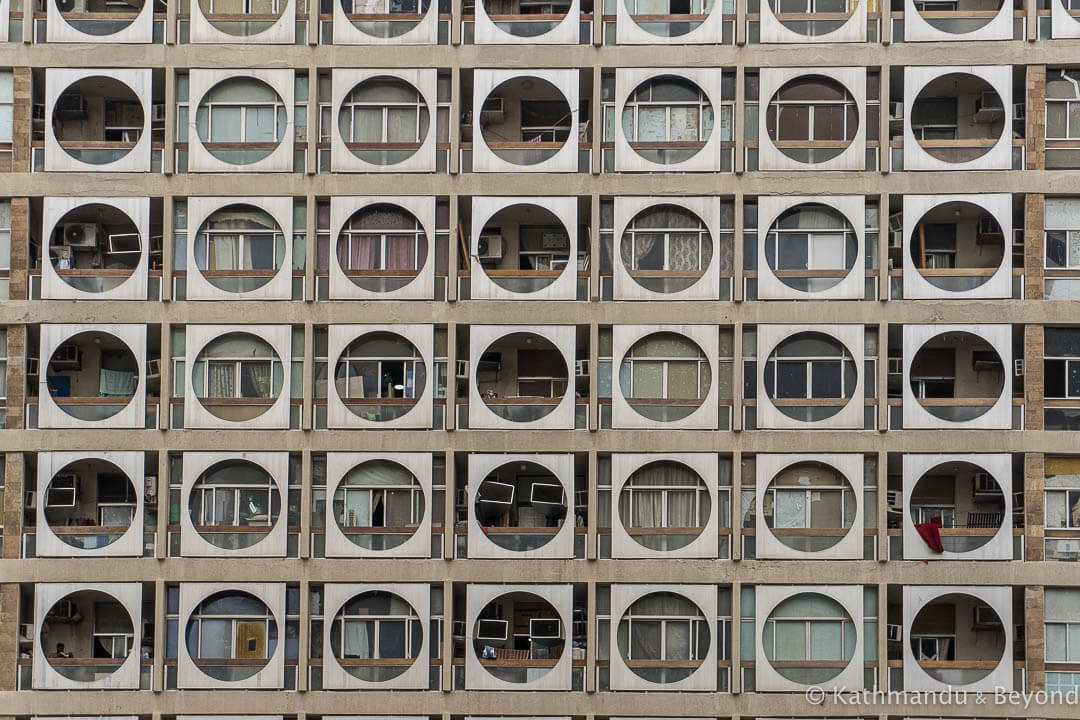
Obeid Al-Mazru’i Building (“Connect Four” building)
Locating Abu Dhabi’s original modernist architecture
The good news is that the majority of the buildings listed below are either in or close to downtown Abu Dhabi and can be seen on foot. The bad news is that you will have to walk a fair number of miles if you want to see them all. If the heat is too much, or you just don’t fancy walking, then Abu Dhabi does have a fairly decent bus network that covers most of the city.
If you are short on time, or just want to incorporate some of Abu Dhabi’s early modernism into your sightseeing plan, then the largest concentration of buildings can be found on Electra Street (officially Zayed 1st Street but so-called because of the high number of shops selling electronic goods) and the few blocks either side of it.
A note about photographing buildings of this nature in Abu Dhabi
I should point out that there are a number of vigilant security guards in Abu Dhabi so be careful when you get your camera out and what you point it at. There’s no need for paranoia but at places such as the bus station or sports centre, for example, you may be approached to find out what you are doing. This only happened to us on a couple of occasions but, as a result, we were (politely) asked to delete the photos we had just taken. Don’t argue; just do as they say. The UAE is a welcoming place but if you step out of line the consequences can be harsh.
Examples of Modernist architecture in Abu Dhabi
What follows is a largely pictorial guide to Abu Dhabi’s original modernist architecture. We have included as much information as we could find about the architect and date of construction, but if you can fill in any of the gaps, we would appreciate hearing from you.
Residential Building on Zayed 1st Street (Electra Road)
Year built and architect not known
Hemmed in by two more recently constructed skyscrapers, it’s curious why this particular building has escaped being torn down and reconstructed when so many from the same era have succumbed to this fate. Perhaps it is one of ADACH/’TCA Abu Dhabi’s success stories?
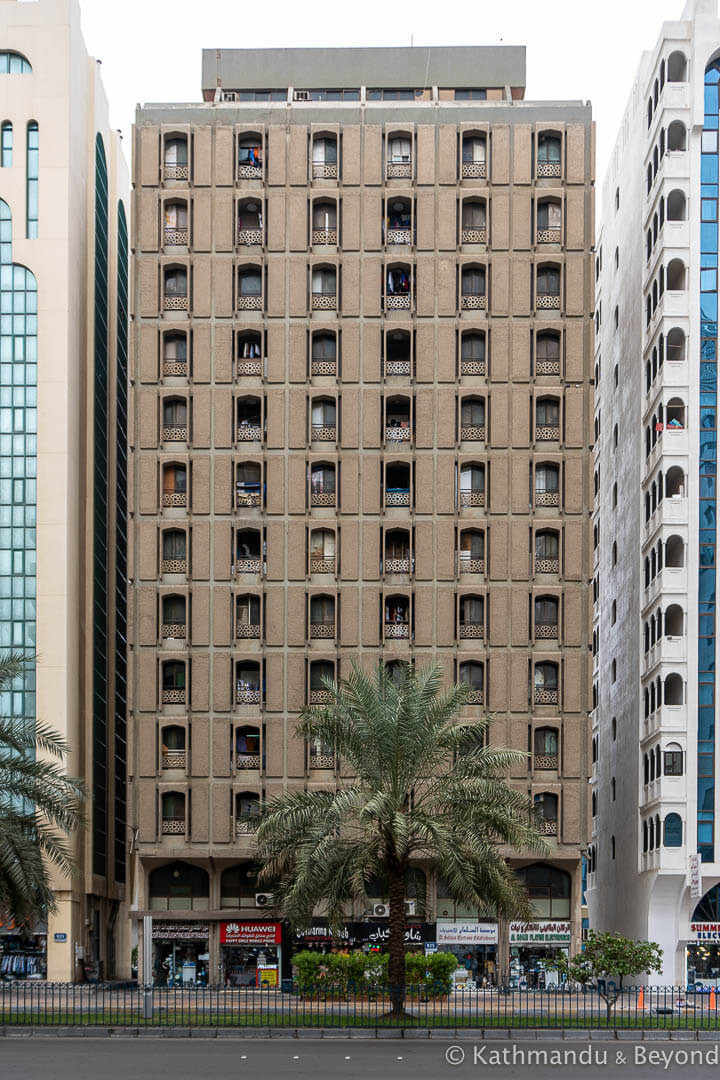
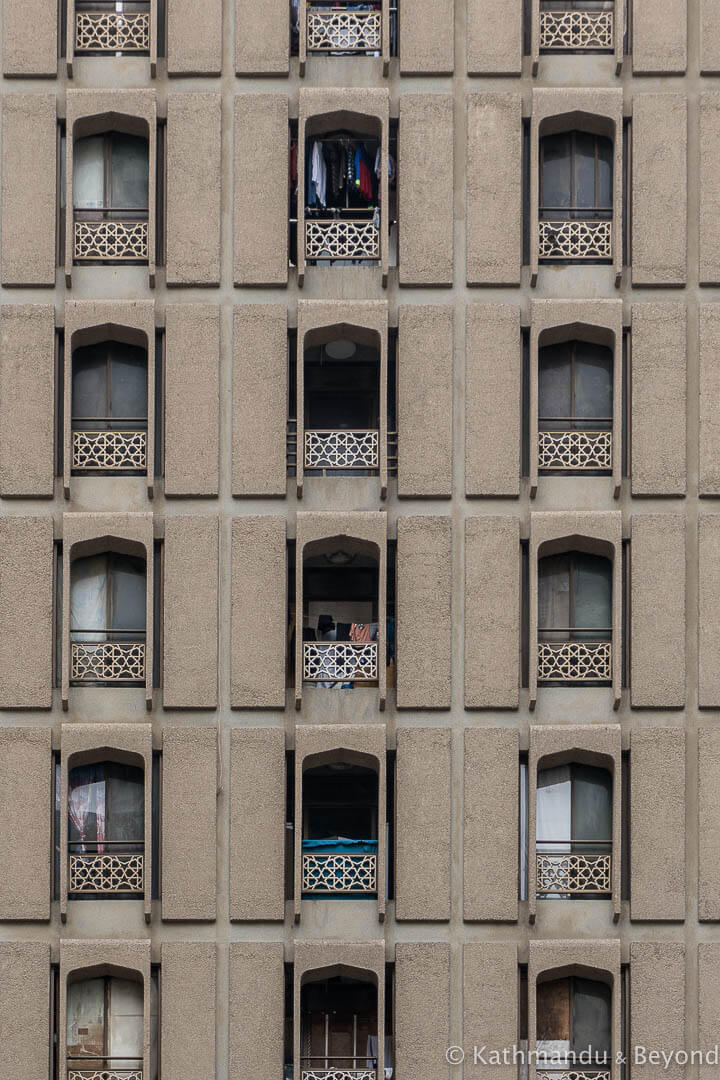
Residential Building on Zayed 1st Street (Electra Road)
Former Abu Dhabi National Oil Company (ADNOC) Headquarters
Completed 1970s
Architect not known but most probably Constantine Kapsambelis, who was responsible for the now-demolished ADNOC Residential Buildings
Despite the fact that the residential buildings mentioned in the intro are no more, the original ADNOC headquarters is still there. These days, however, it is completely overshadowed by the towering new ADNOC skyscraper which was completed in 2015 and is 342 metres high. The fate of the first ADNOC HQ is uncertain but the fact that it hasn’t been demolished is a good sign and there is talk of turning it into a museum or learning centre. It was closed when we visited in November 2019 and renovation work was taking place.
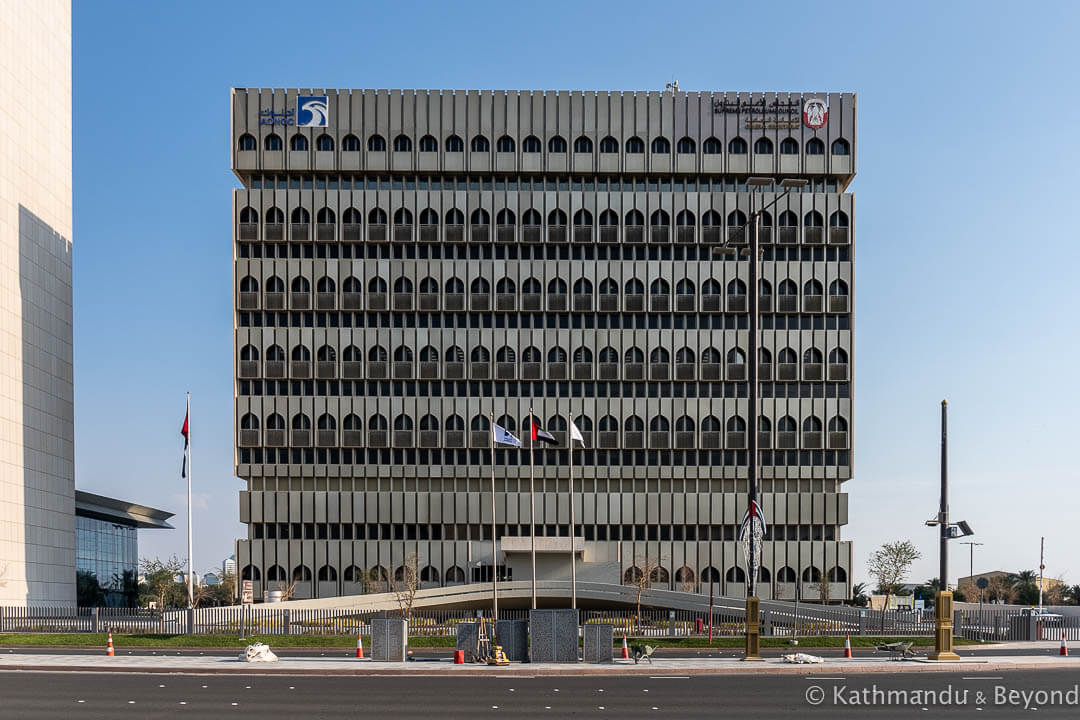
Former Abu Dhabi National Oil Company (ADNOC) Headquarters
Radisson Blu Hotel & Resort (formerly Hilton Abu Dhabi)
Completed 1973
Architect Brashier Lancaster Associates
Not that impressive architecturally, in my opinion, the property is of historical significance because it was the first international chain hotel to be opened in the city. We spent quite some time wandering around the property and were mesmerised by the archive photos in the lobby which show the building in its early days surrounded by absolutely nothing apart from sand and sea. To put this into perspective, I should add that the hotel is situated at the western end of the Corniche which, nowadays, is lined with every style of architecture imaginable along its entire 8km-length.
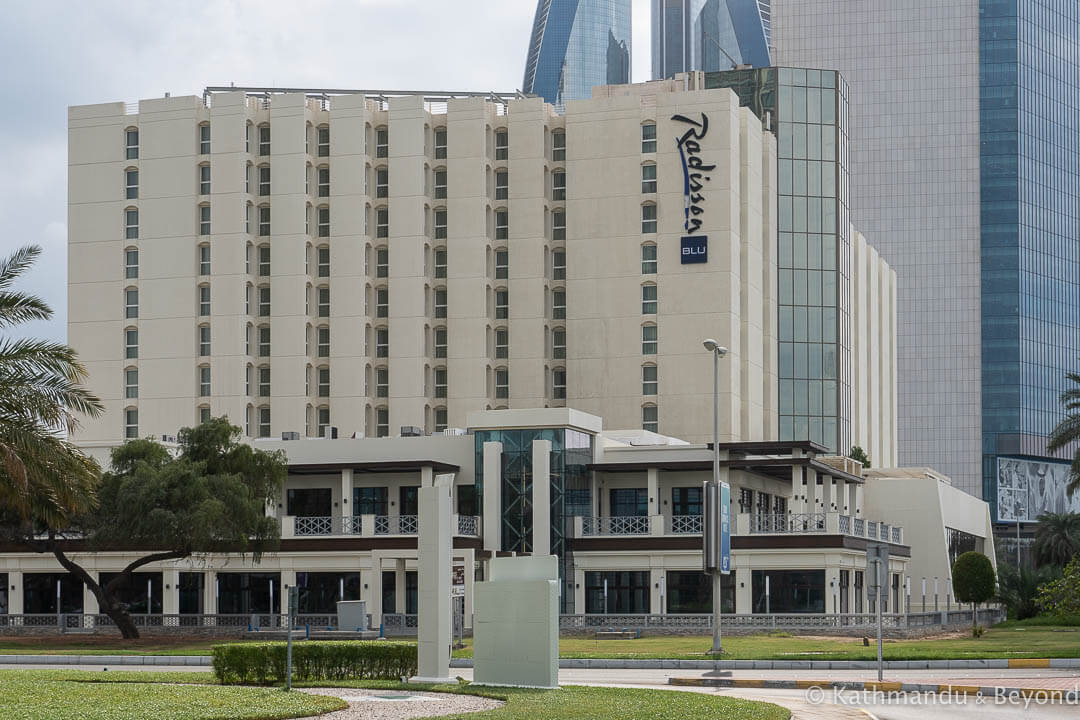
Radisson Blu Hotel & Resort (formerly Hilton Abu Dhabi)
Al-Ibrahimi Building
Completed 1980s
Architect Farouk El Gohary
Designed by Egyptian architect, Farouk El Gohary, this 16-storey cylindrical skyscraper is still one of the most dominating structures in downtown Abu Dhabi. Named after the restaurant situated on the ground floor (which used to be the go-to place for wedding parties, etc.), this imaginative structure is one of the city’s modernist highlights. It’s difficult to do it photographic justice from Electra Street, on which it is located, but if you head down the side street to the left of the building for some distance and look back, you’ll be able to fully appreciate its fantastic design.
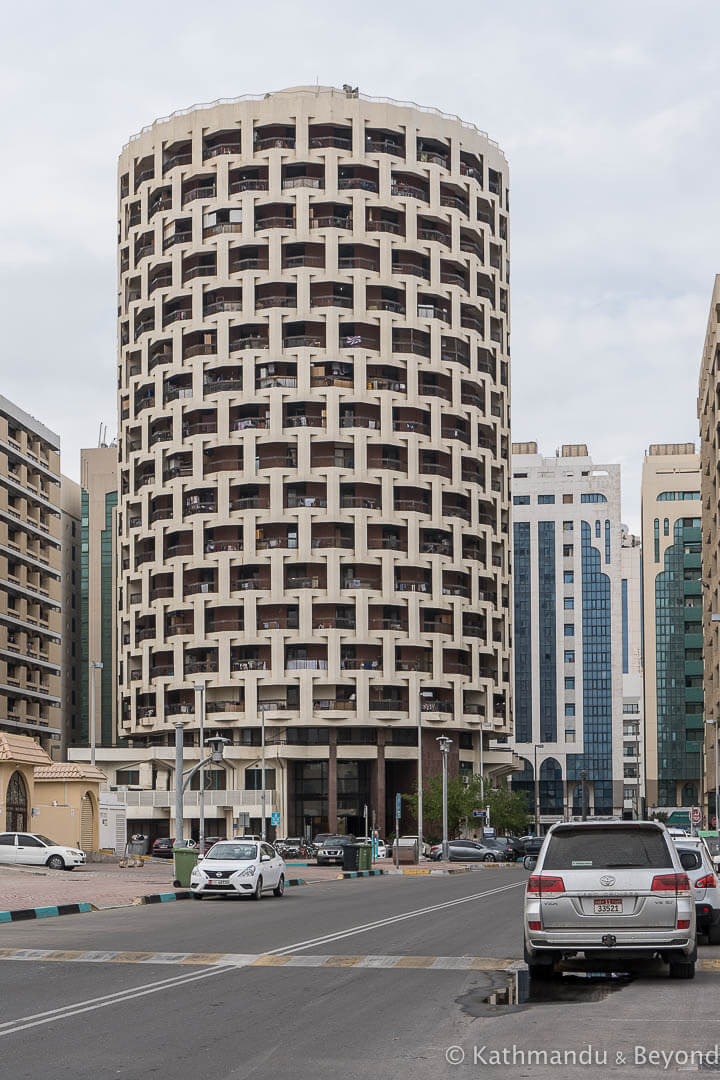
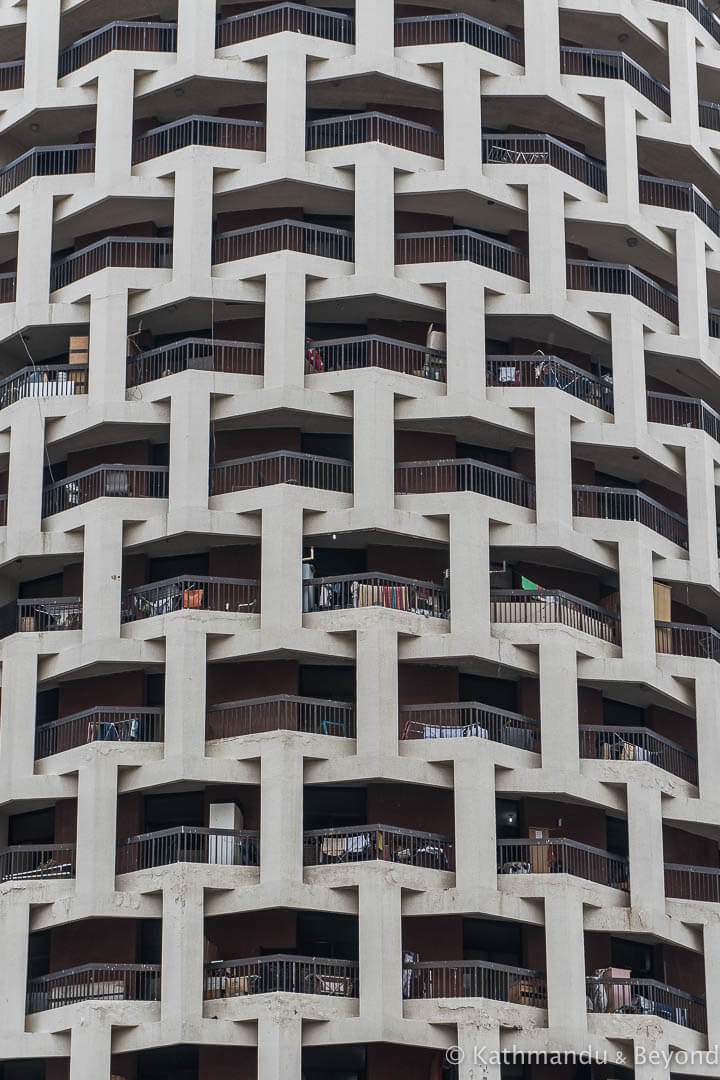
Al-Ibrahimi Building
Harib Tower
Year built and architect not known
What makes me think this building was constructed in, or before, the 1980s is the fact that is flanked by taller, more modern skyscrapers on either side which highlight how dated it looks. Otherwise, I can find no other information about this tower block.
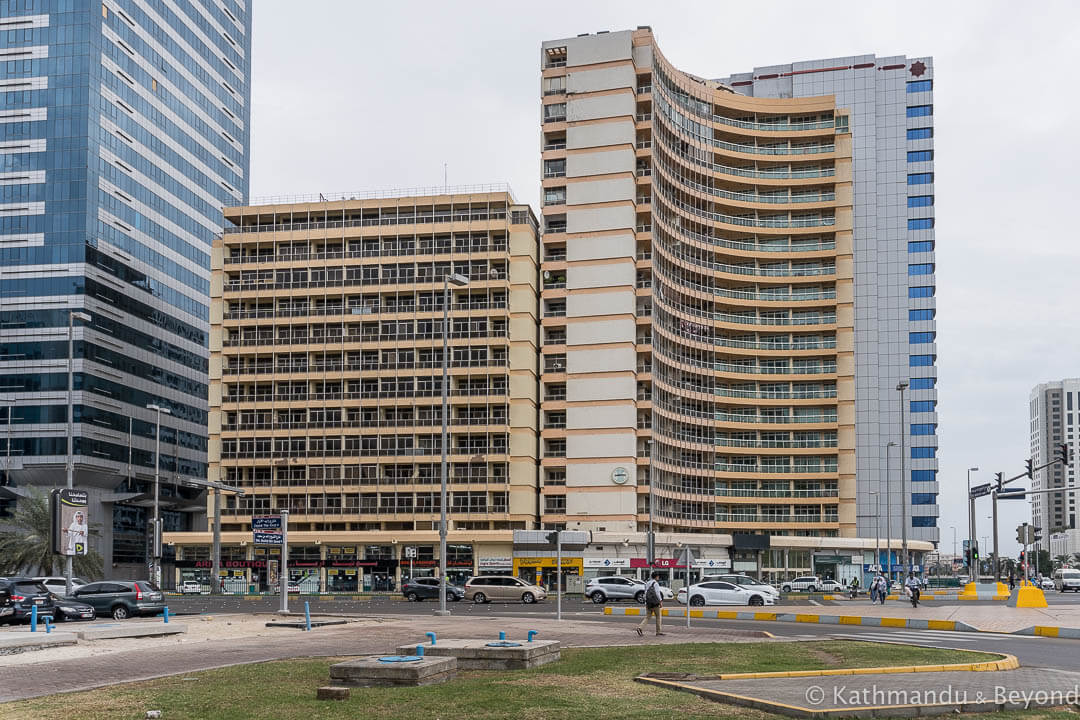
Harib Tower
Obeid Al-Mazru’i Building (“Connect Four” building)
Completed 1980s
Architect not known
Earning its nickname from the game Connect Four because of the circular pattern on the building’s facade, the practical reason for the design was to prevent sunlight from directly streaming into the individual apartments thereby keeping them cooler. It is highly likely that the inspiration for the design came from the 1960s Koujak-Jaber Building in Beirut, Lebanon (Architect Victor Bisharat).
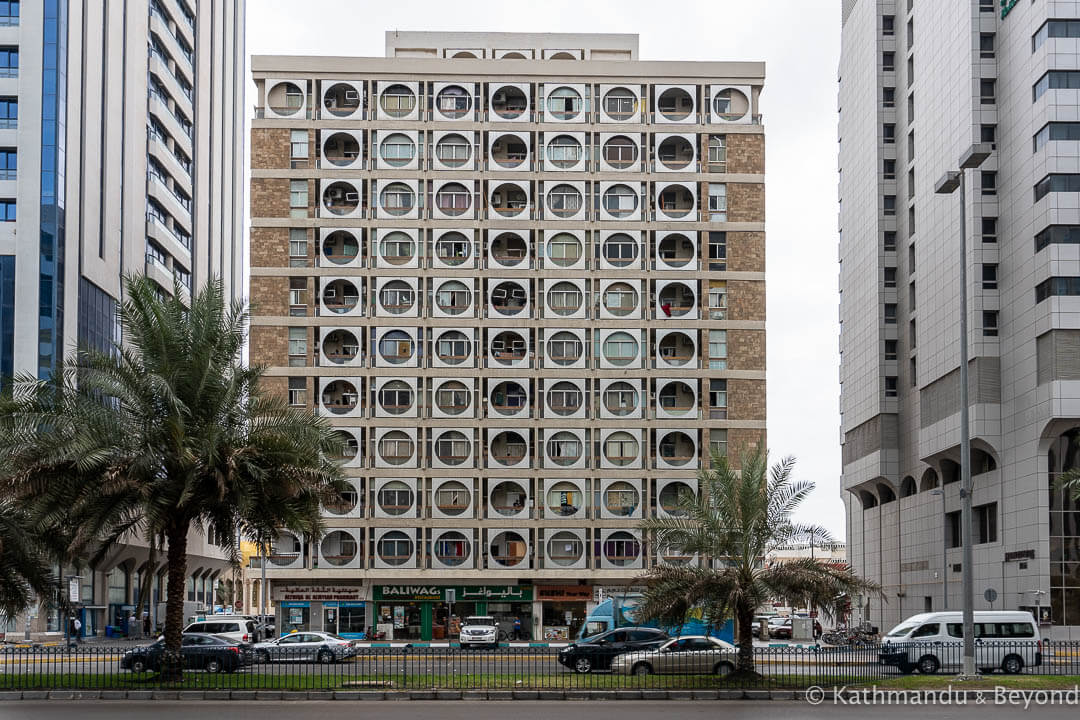
Obeid Al-Mazru’i Building (“Connect Four” building)
Toilet Block in Post Office Park
Year built and architect not known
Believe it or not, this is not the first time a toilet block has been mentioned in architectural context on our blog – two French colonial-era public conveniences used to be situated near the National Museum in Phnom Penh and I mentioned them in our post about architecture in the Cambodian capital. As for this toilet block – apart from its location, I don’t have any other details about it except that it functioned properly when I made use of it!
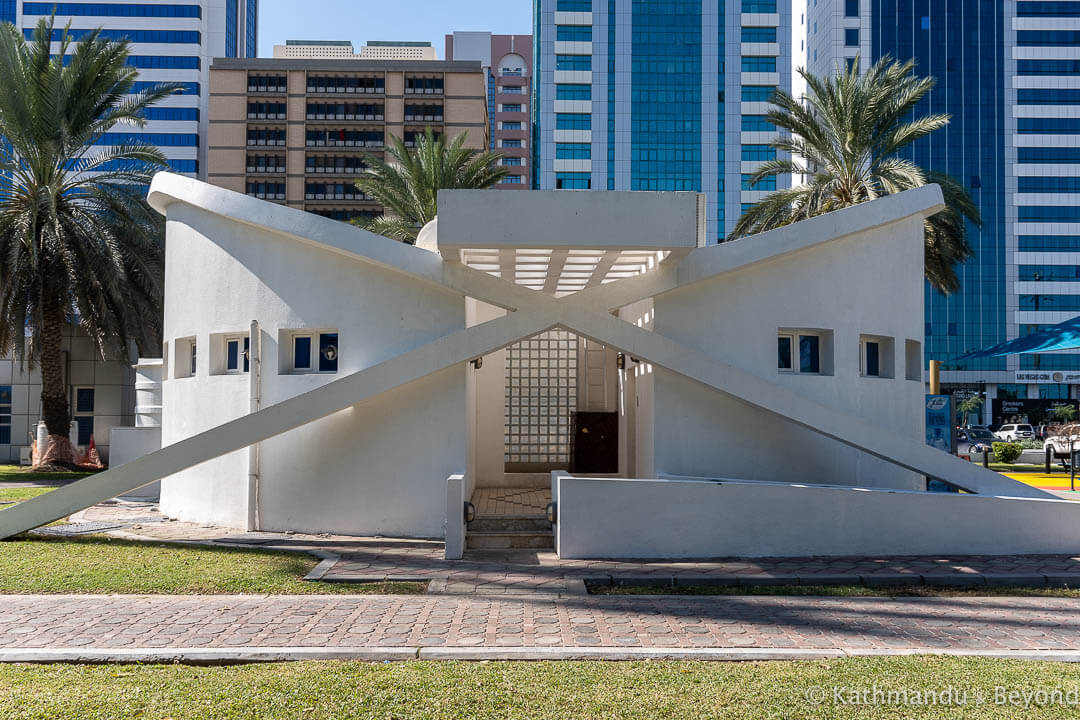
Toilet Block in Post Office Park
Abu Dhabi Central Bus Station
Completed 1989
Architect Bulgarconsult/Georgi Kolarov
If you only see one of Abu Dhabi’s modernist buildings then I would recommend it be this one. Painted in Islamic (mint) green, there is so much detail to look out for at the city’s central bus station that, if you were that way inclined, you could easily spend a couple of hours taking it all in. To begin with, there are the two control towers, one either side of the main terminus, that look like a couple of landed UFOs. Then there are the concrete waves of the taxi stand, that may or may not still be there by the time you read this. Even the pokey adjacent cafe, which of course we frequented for a cup of tea, oozes 1980s’ retro-ness. There are two vantage points from where you will get a completely different perspective of the main body of the bus station. Opposite its western entrance is a pedestrian overpass that crosses busy Al Wahdah Street. From the top of the stairs you get a great overview of the complex, while if you venture to the other side of the road opposite the eastern entrance to the station you can obtain a neck-craning view of its shapely curves.
If it sounds like I am a bit smitten with this futuristic structure, I am, and wouldn’t hesitate to place it in my top-ten favourite buildings of this particular genre if I had such a list (*).
(*) That sounds like a good idea for a blog, which I might tackle one of these days!
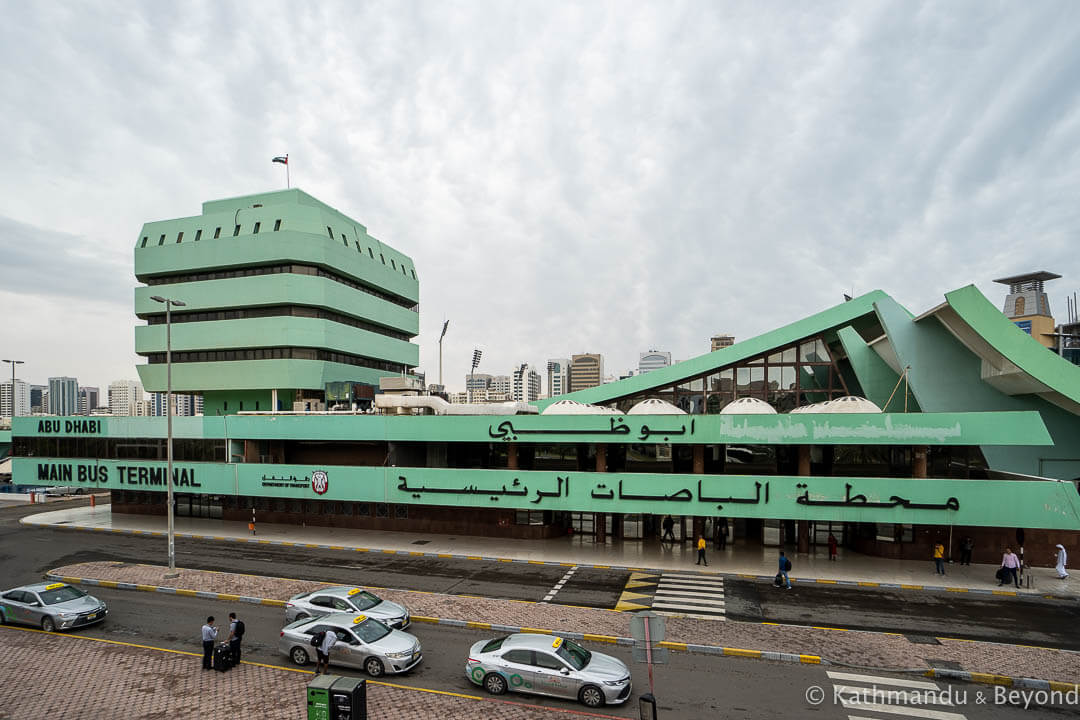
Abu Dhabi Central Bus Station
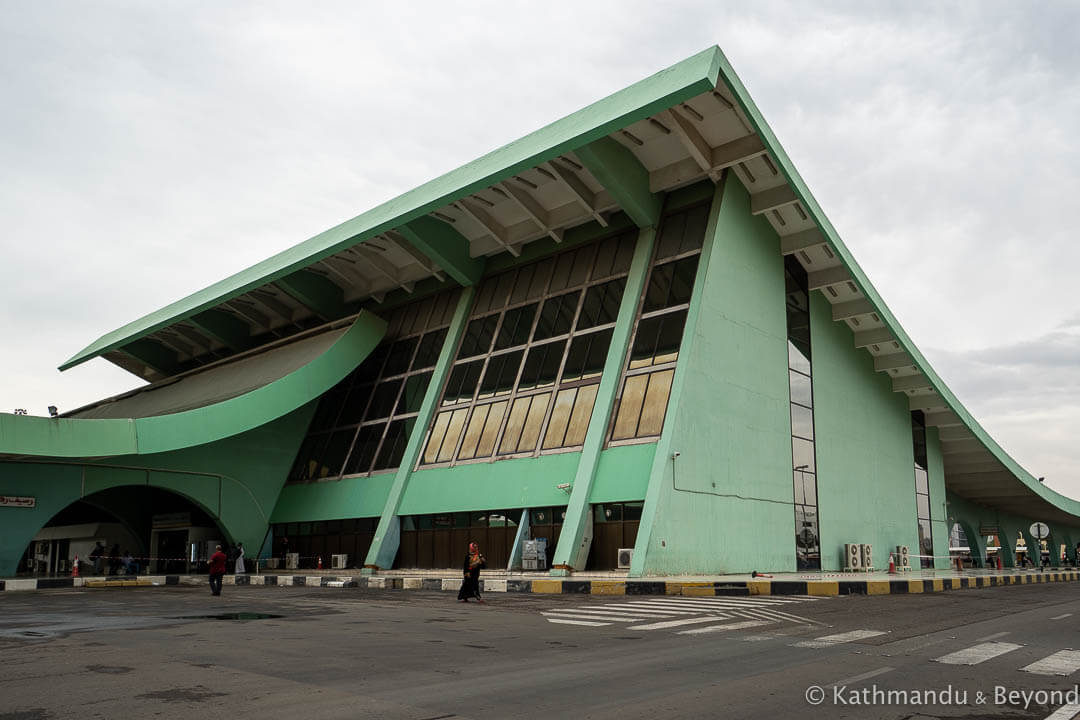
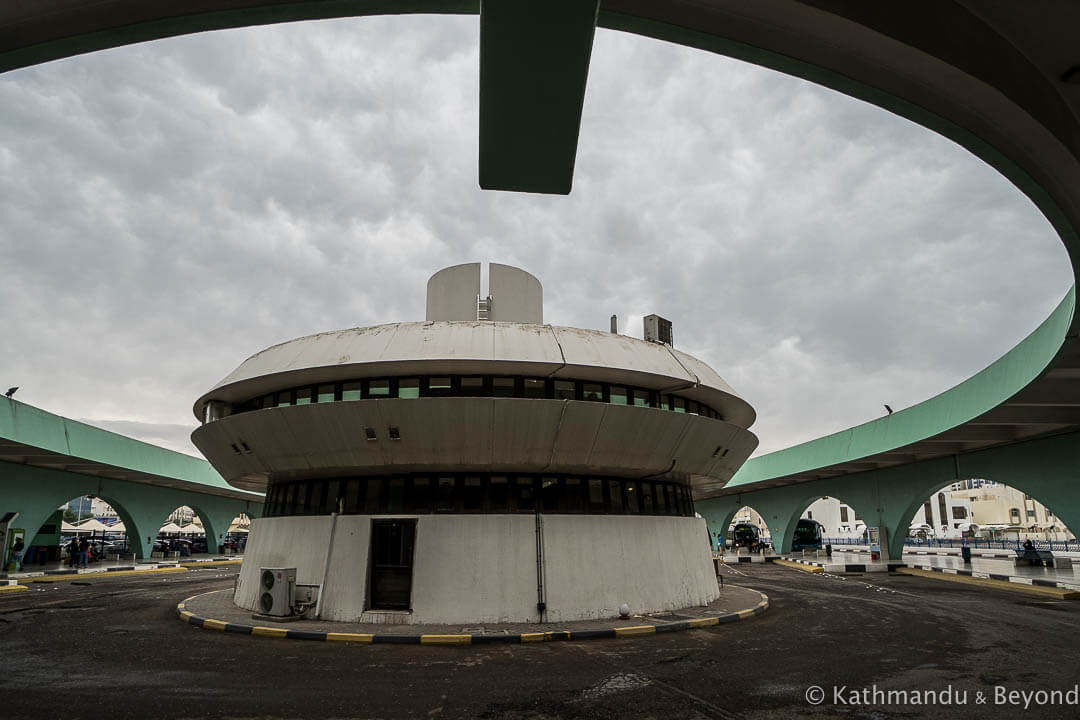
Abu Dhabi Central Bus Station: terminal building (left) and control tower (right)
Al Bateen Mall
Completed 1986
Architect Technoexportstroy
Rather modest in size compared to malls in the UAE these days (or anywhere, come to think of it!), this and the bus station mentioned above were designed by Bulgarian architects. In fact, with its central arch and two sweeping concrete canopies, it should come as no surprise to learn that Al Bateen Mall was originally built as a bus station. It was converted into a hypermarket in the mid-1990s. As far as we could make out when we went to see it, the most popular thing about Al Bateen Mall was the takeaway juice bar near the main entrance. We witnessed a continuous stream of cars rolling up and shouting out their orders from wound down windows (locals don’t like to get out of their vehicles that much in the UAE) to the guys in the serving hatch. It was such a constant in fact, that in the end, we gave up trying to get a photo of the mall without any cars in front of it.
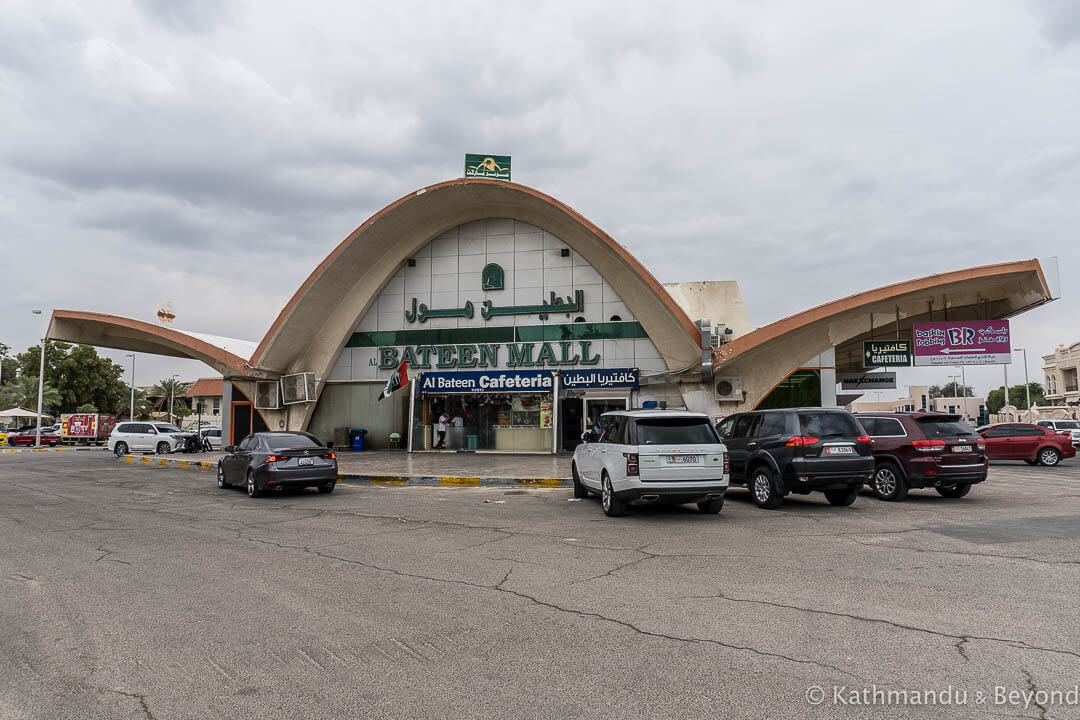
Al Bateen Mall
Abu Dhabi Chamber of Commerce and Industry
Year built and architect not known
I can’t tell you very much about this high-rise structure apart from the fact that it is twenty-five storeys and used by both the government and commercial sector. Assuming it does qualify as an original modernist building, I would conjecture it would have been one of the tallest in the city when it was originally erected but, at approximately 104 metres in height, it doesn’t even make it into Abu Dhabi’s top twenty tallest structures these days.
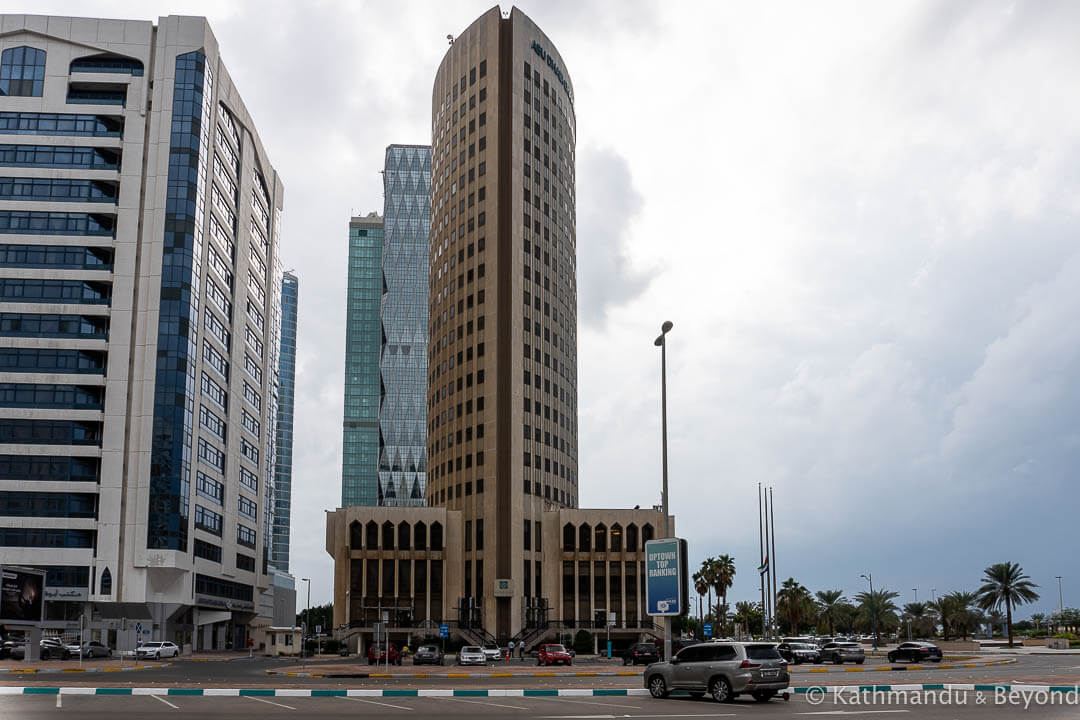
Abu Dhabi Chamber of Commerce and Industry
Sheraton Abu Dhabi Hotel and Resort
Completed 1979
Architect Rothermel Cooke
At the other end of the Corniche from the Radisson Blu, the Sheraton is another of Abu Dhabi’s original hotels. Conjuring images of grain silos, the vertical cylinders that have been so dominantly incorporated into the hotel’s design are not there just to provide privacy between balconies but also function as a small workspace/nook inside the rooms to which they are attached. When the property was first built, it looked out directly onto the Persian Gulf but is now distanced from it by reclaimed land and a highway running along Corniche Street.
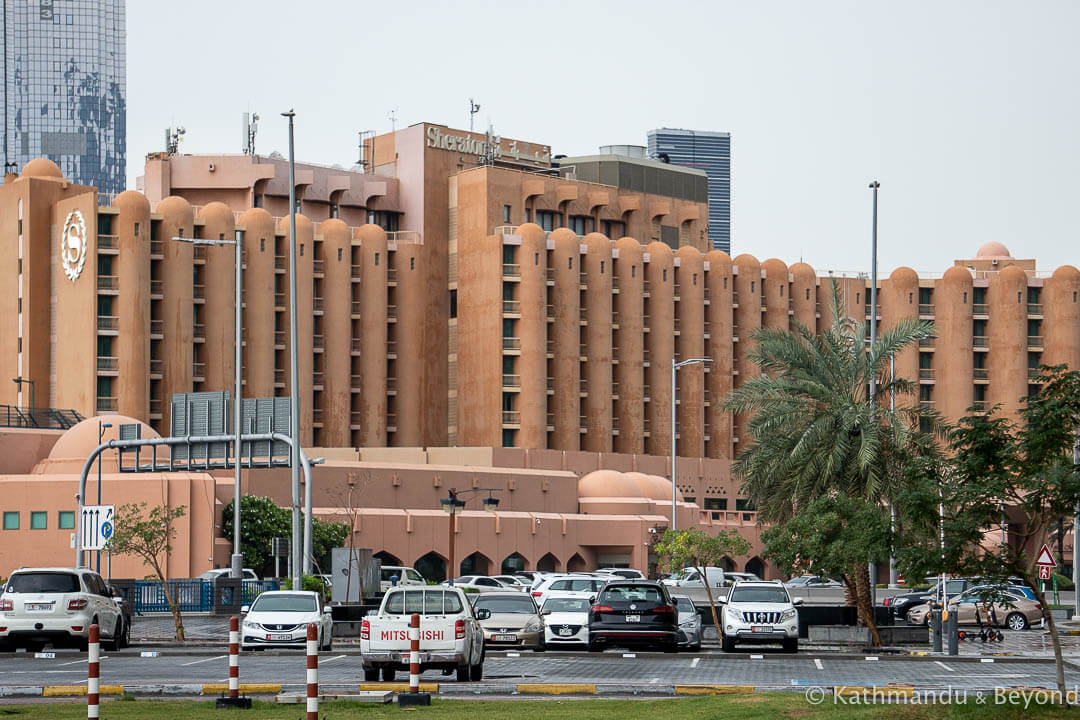
Sheraton Abu Dhabi Hotel and Resort
Al Omaira Building
Completed 1980s
Architect not known
Sitting at the eastern end of Hamdan Street, Al Omaira is surrounded by other residential buildings but stands out because of its eye-catching jade-coloured facade which consists of a large number of ceramic tiles. Once seen as an upmarket apartment unit, over time and with the development of swankier places to live, it has lost this status and is now mostly affordable living quarters for some of the city’s high percentage of immigrant workers.
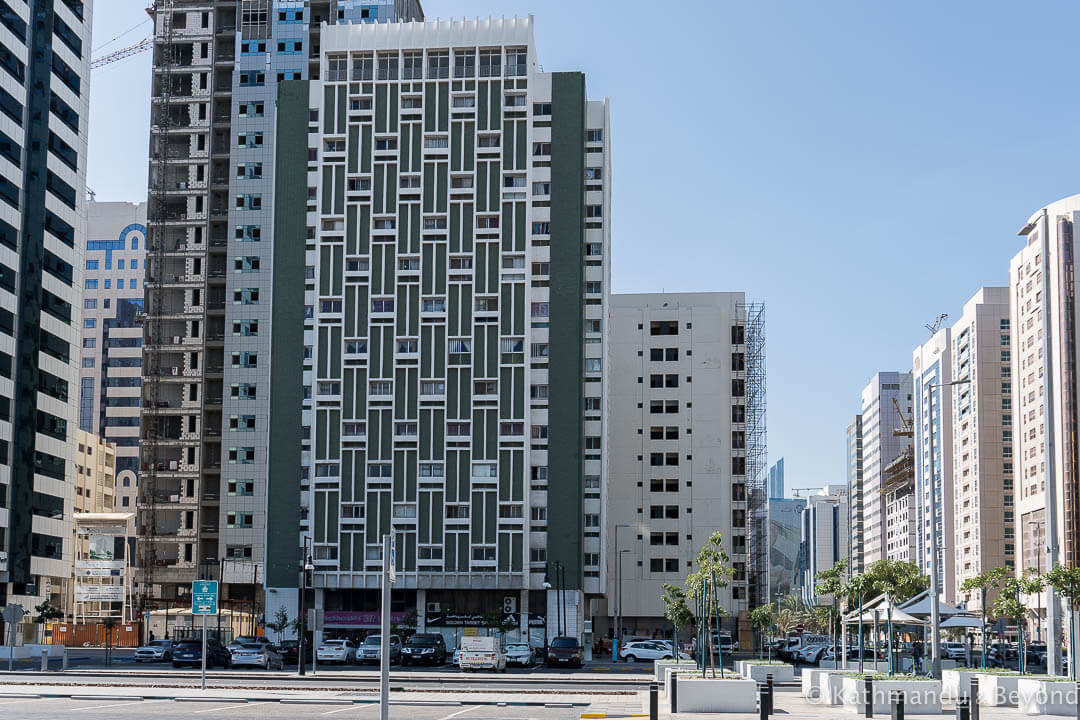
Al Omaira Building
Abu Dhabi Vegetable Market
Completed 1985
Architect Spectrum Engineering
Our timing was terrible when we visited this modernist-designed souq. I think even if we had been a few hours earlier, or gone the day before, we would have seen the market in its original form and minus the ghastly paint job that was being so rigorously applied to it. It pissed me off so much that I only took one photo, at Kirsty’s insistence, and we didn’t bother to venture inside!
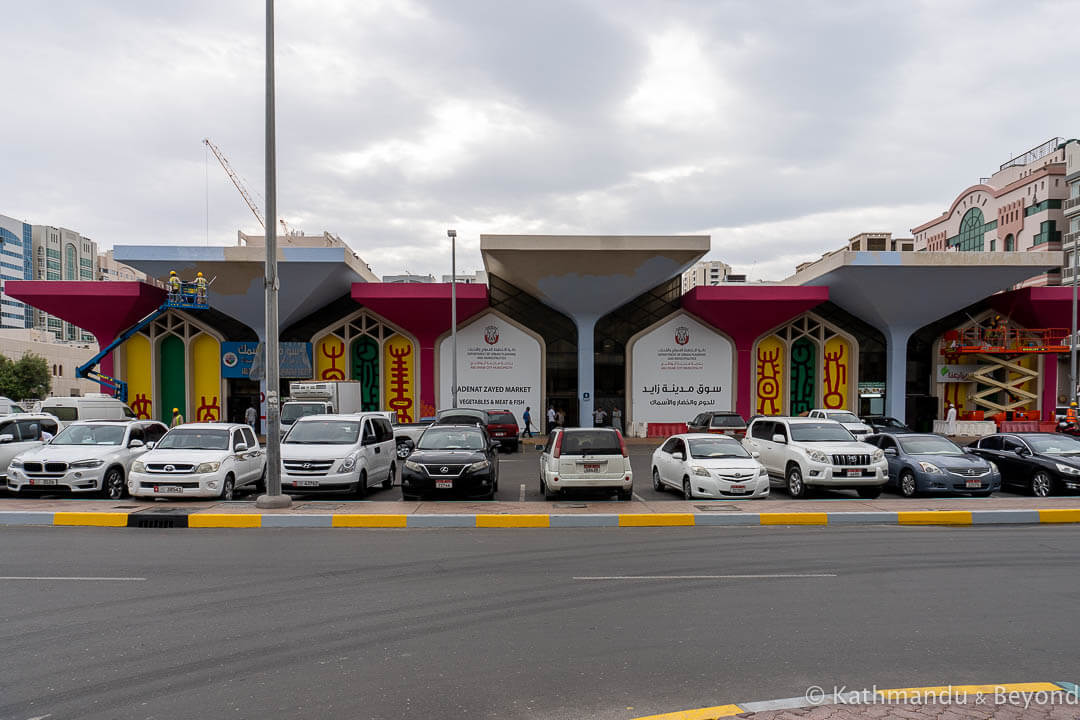
Abu Dhabi Vegetable Market
Abu Dhabi Municipality
Completed 1985
Architect Bulgarproject/Dimitar Bogdanov
Surrounded by other government departments, Abu Dhabi Municipality is the largest and most striking building in this part of the city. Incorporating Arabic context and character into its design, the Municipality is a striking collection of geometric contours that blend well with their surroundings. I especially liked the style of the Harun Al-Rashid Mosque, which looks as if it might have been added later but is still part of the Municipality complex.
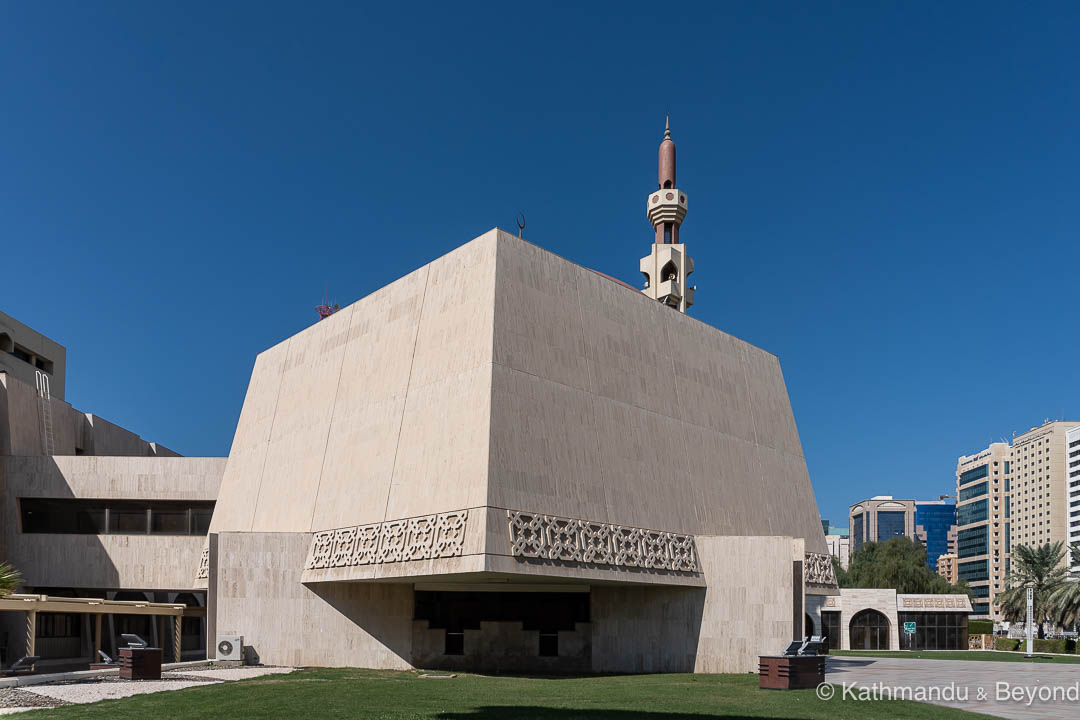
Harun Al-Rashid Mosque
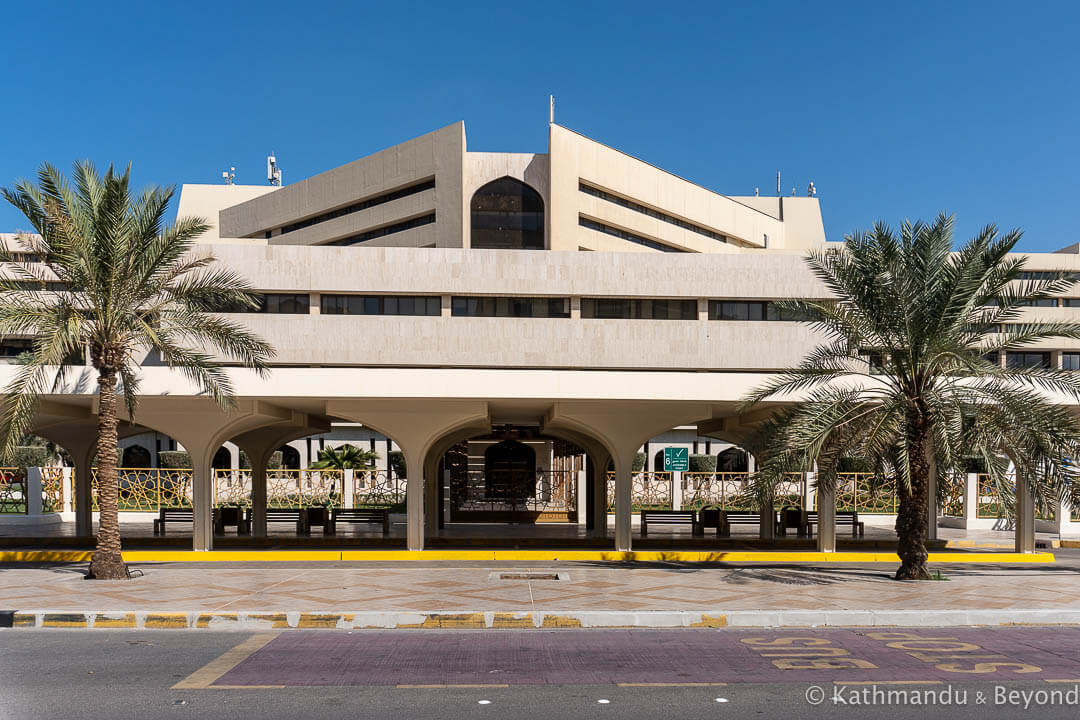
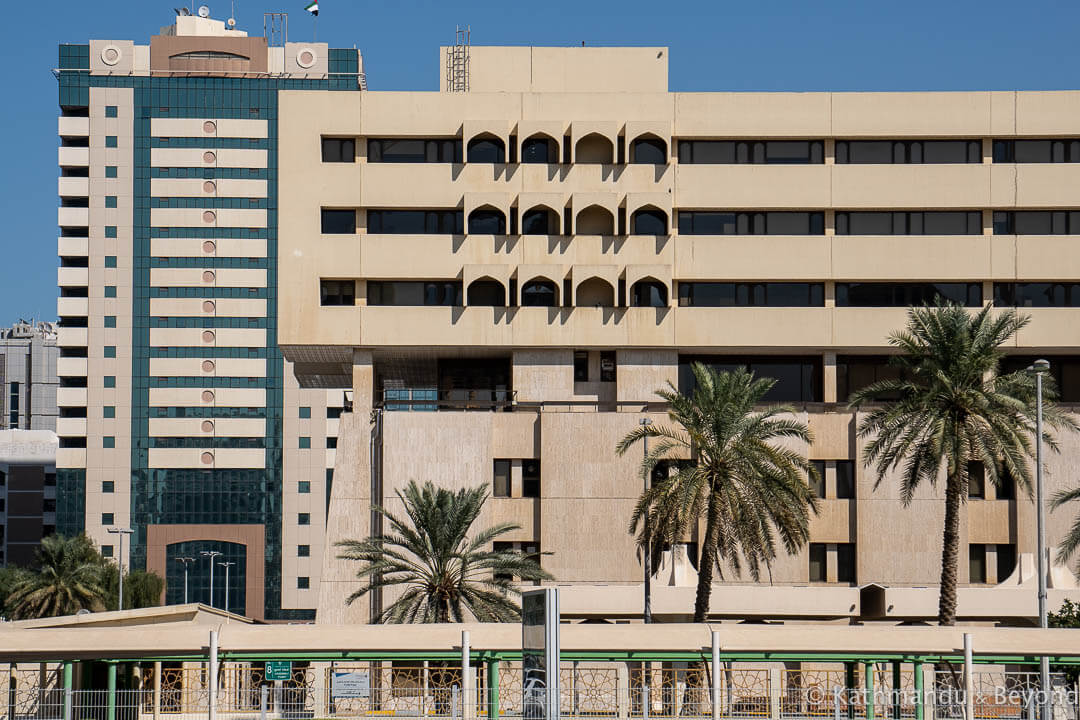
Abu Dhabi Municipality
Buty Al-Otaiba Tower
Completed 1982
Architect ADC Jamal Najjar and Ziki Homsi Architectural Design Consultants
Located on Electra Street and yet another building that is way easier to photograph from behind, Buty Al-Otaiba Tower is seventeen floors of countless hexagonal windows that, unlike some of the other buildings from the same era, doesn’t especially show its age. If you look close up, you will notice the odd splash of colour juxtaposing the structure’s otherwise dominant creme-coloured facade.
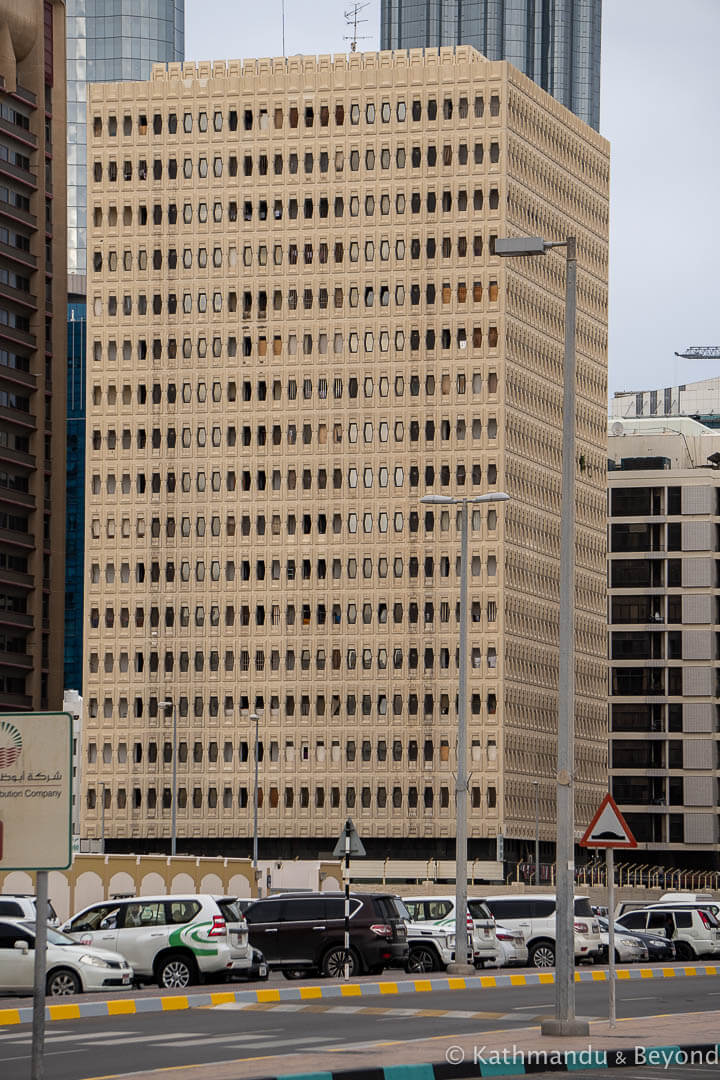
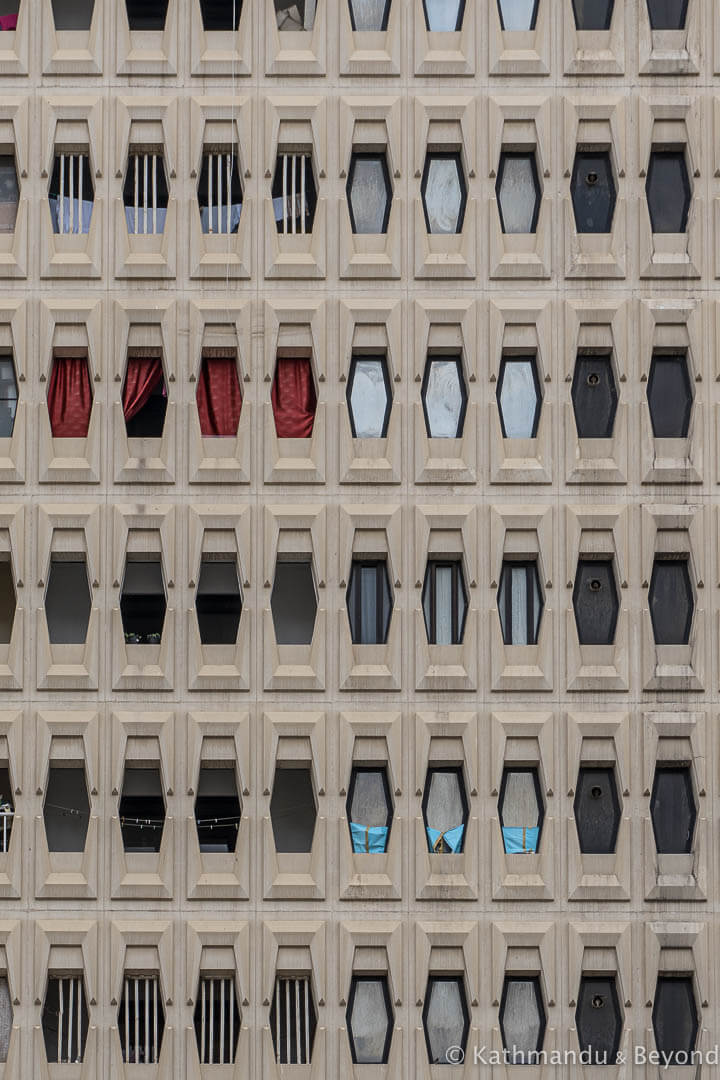
Buty Al-Otaiba Tower
Hamed Centre
Completed 1980s
Architect not known
The Hamed Centre is next door to Buty Al-Otaiba Tower so it makes sense to mention it here. Comprising two buildings, although it doesn’t look like it at first glance, they are connected via a walkway on the third floor. The concrete ‘slats’ are incorporated into the design to help protect the interior of the buildings from the sun but I’m not sure if the portholes have a function or whether they are purely aesthetic. Peering up at the small diamond-shaped windows reminds me of Welbeck Street car park in central London.
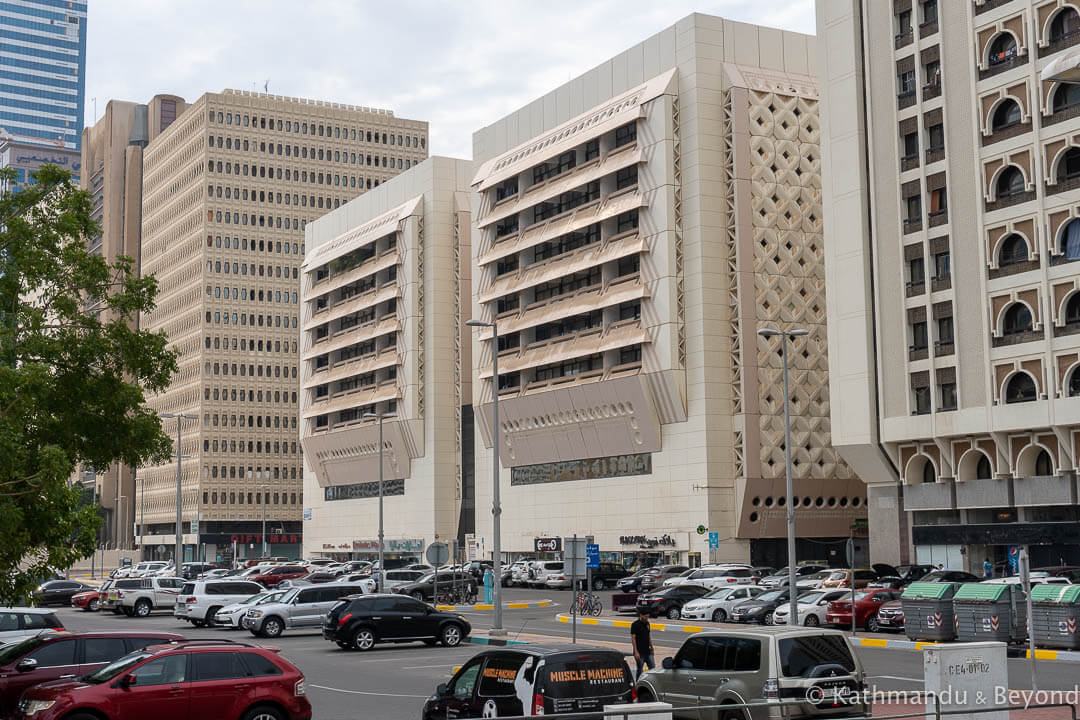
Hamed Centre
Apartment Building on Sultan Bin Zayed the First Street
Year built and architect not known
I have no information about this building. I’ve presumed this apartment building belongs to Abu Dhabi’s original modernist period partly because of its appearance and partly because the surrounding high-rise buildings appear to be of a more contemporary design style.
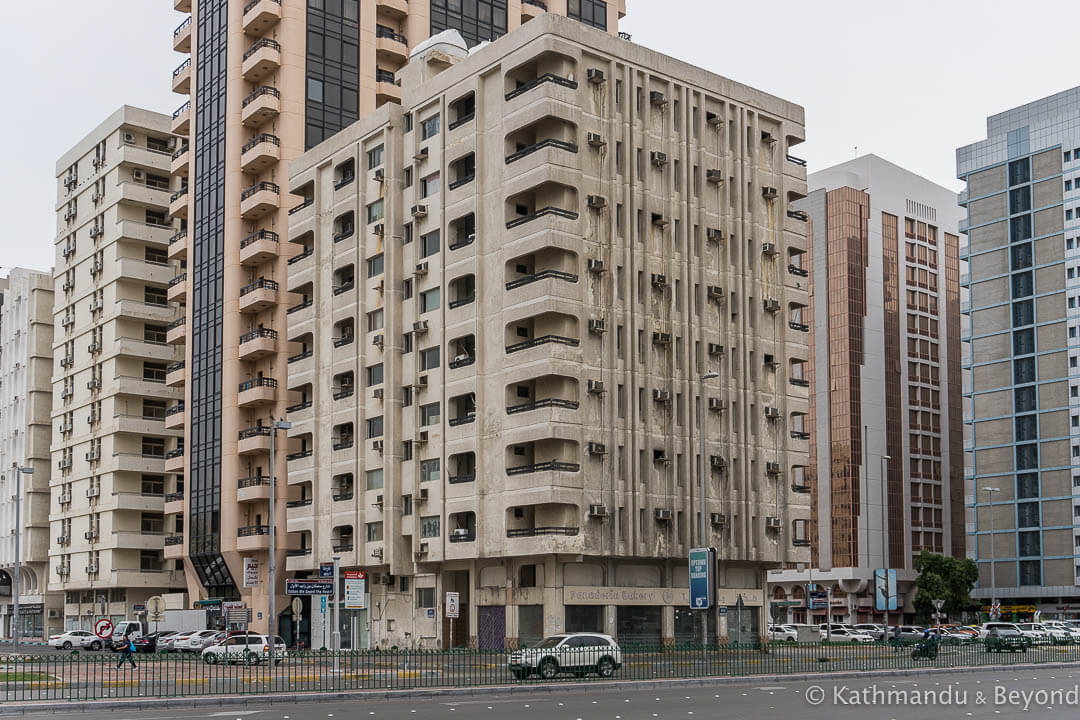
Apartment Building on Sultan Bin Zayed the First Street
InterContinental Abu Dhabi
Completed 1980
Architect Benjamin Thompson and Associates
To me, this solid hotel definitely has an air of Sovietness about it, although, in this instance, the architect firm that designed it was American. Along with the Radisson Blu (then the Hilton) and the Sheraton, the InterContinental played an important role in kickstarting Abu Dhabi’s tourism industry.
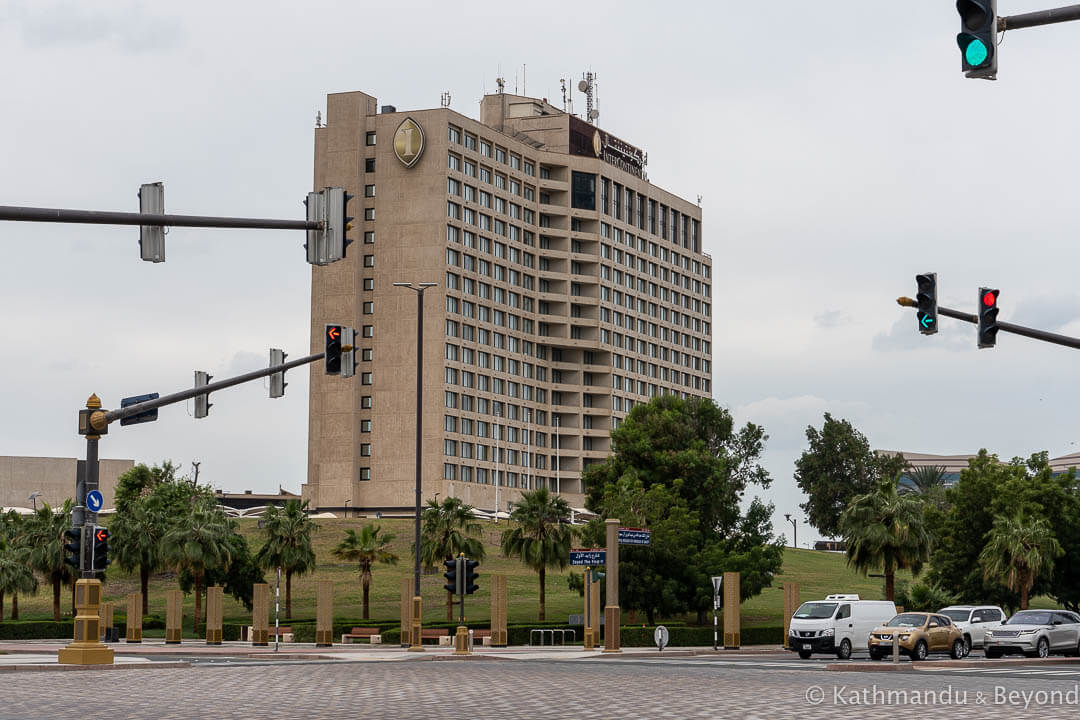
Zayed Sports City Stadium
Completed 1979
Architects Henri Colboc, Pierre Dalidet and George Philippe
The reason I only have this one, rather pathetic, shot of the stadium is it was one of the places where I was approached by a security guard. Something was happening in preparation for an event and I think under normal circumstances it would have been fine to photograph the place. I mean, how can you stop people, at say a football match, from getting their phones out and snapping away?
Anyway, the stadium, which is the largest in the UAE and resembles a Roman colosseum, was designed by French architects and is worth stopping to see if you are en route to the magnificent Sheikh Zayed Grand Mosque, which is only about 5km away (*). Back when it was built, there was nothing else around the stadium and it must have looked quite a sight surrounded by just the shimmering desert.
(*) The Sheikh Zayed Grand Mosque, which dates from 2007, is not part of this post but, without question, you should have it on your agenda if visiting Abu Dhabi.
Other buildings and facilities, some of which were constructed in the 1980s, were added to the complex after the stadium was up and running. I’m assuming one such building was the Abu Dhabi Sports Council, although I can’t verify this and it may well have been added much later in the same way the International Tennis Centre was in 2004, for example. It’s hard to tell sometimes, as you can see from the final two buildings listed in this post.
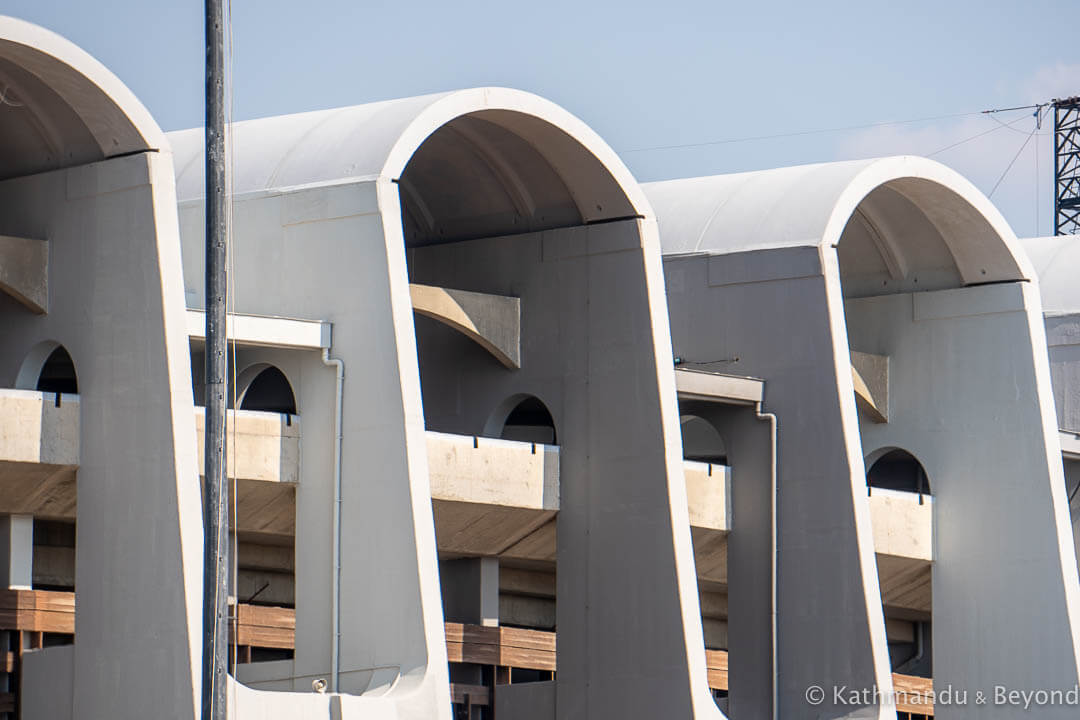
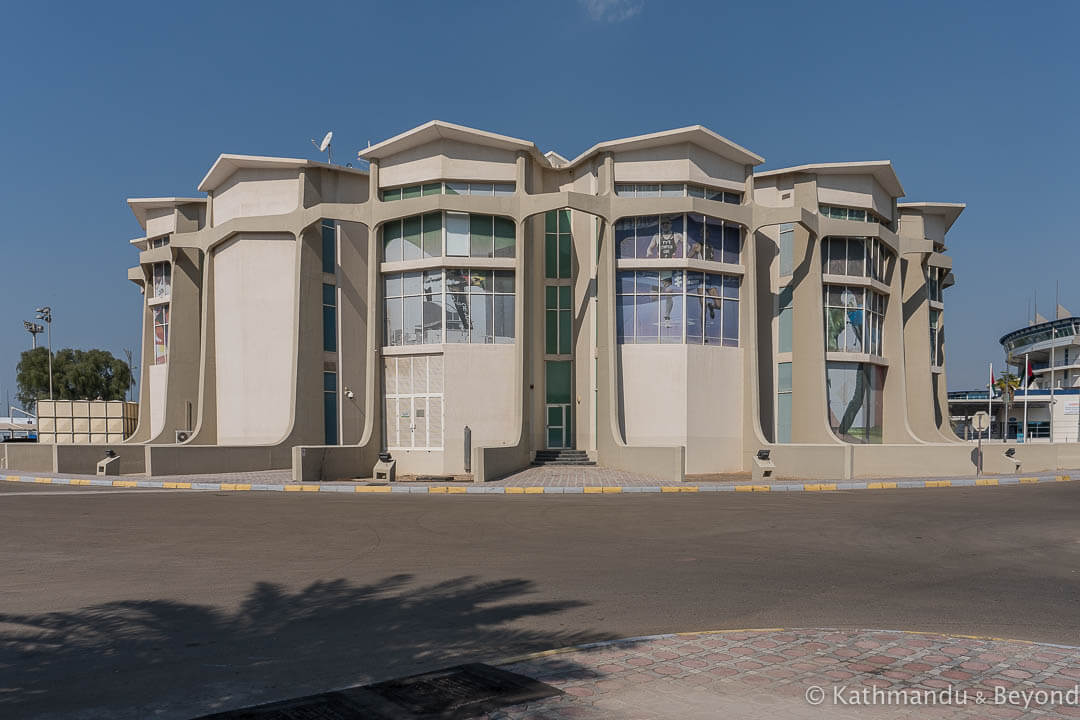
Zayed Sports City Stadium (left) and the Abu Dhabi Sports Council (right)
And finally …
In addition to the buildings already mentioned that have questionable early modernist origins, here are two more in the same debatable category. They are not too far from one another but they are quite a distance east of the centre of Abu Dhabi.
Administration Building, part of Al Rahba Hospital
The interior of this circular structure was certainly dated enough to be from the 1980s. Whenever I’ve shown photos of this building to people with an interest in Soviet architecture, the first thing they point out is its similarity to Chorsu Bazaar in Tashkent (Uzbekistan).
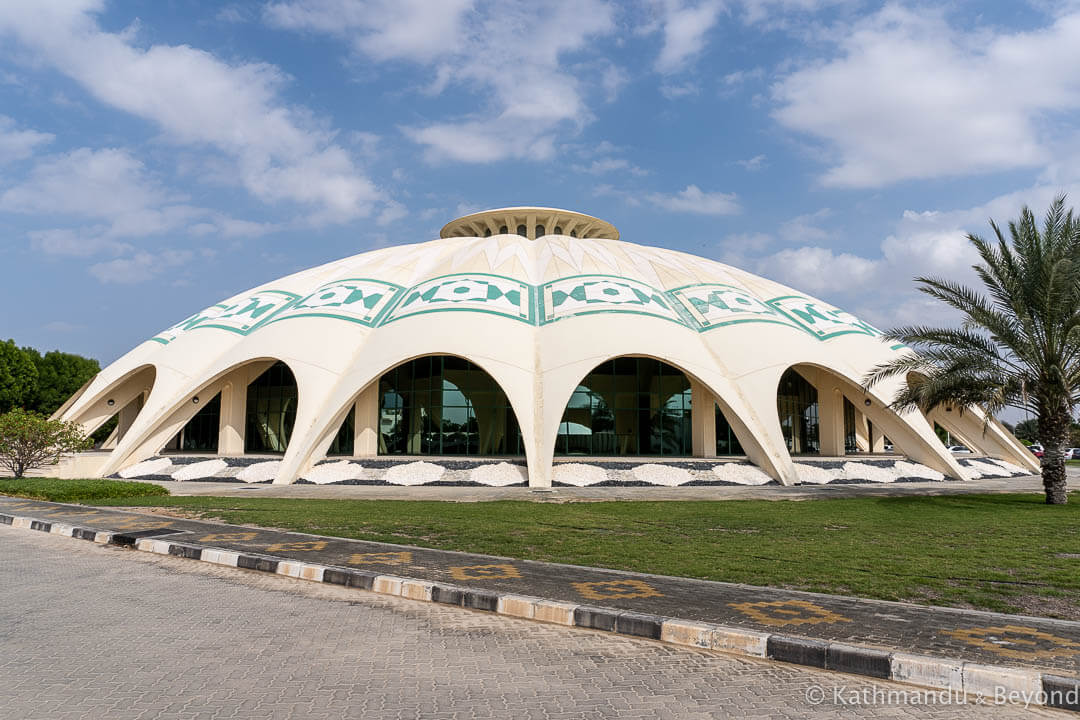
Administration Building, part of Al Rahba Hospital
Shahama Green Market
Yet again, it was the outmoded interior that made me think this market dated from the early days of Abu Dhabi’s urban development. Apart from the highway to Dubai running past, there isn’t that much development near the market so if it is thirty-five years or older, it must have been in the middle of nowhere when it was originally constructed.
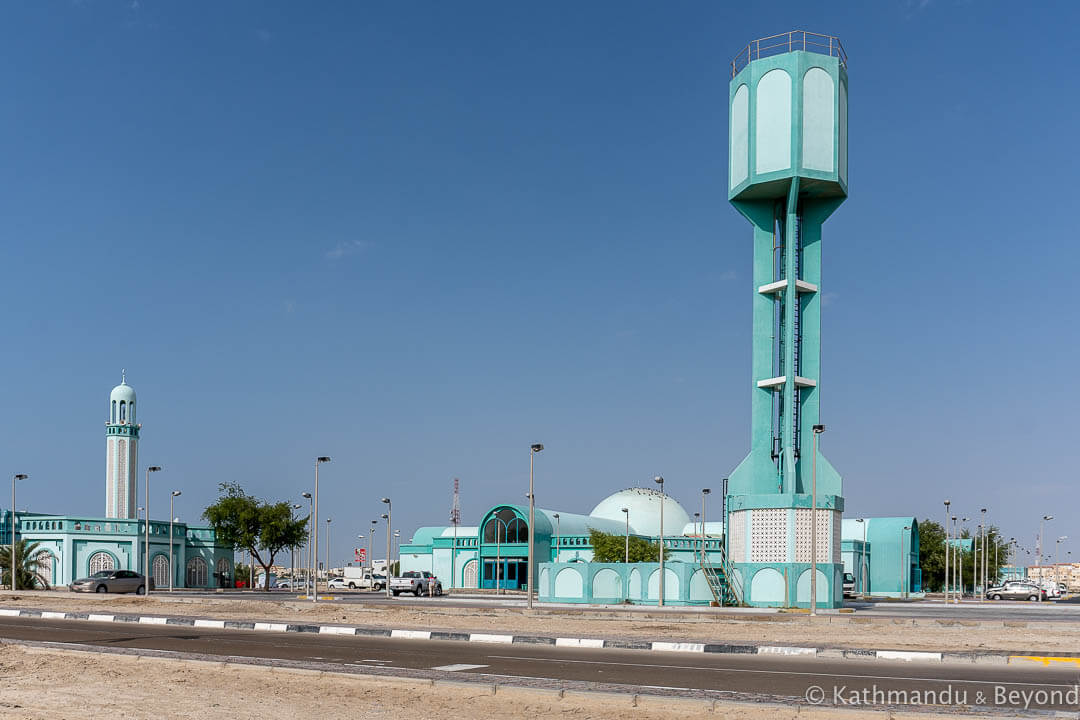
Shahama Green Market
IF YOU ENJOYED THIS PHOTOGRAPHIC GUIDE TO MODERNIST ARCHITECTURE IN ABU DHABI, PLEASE SHARE IT…
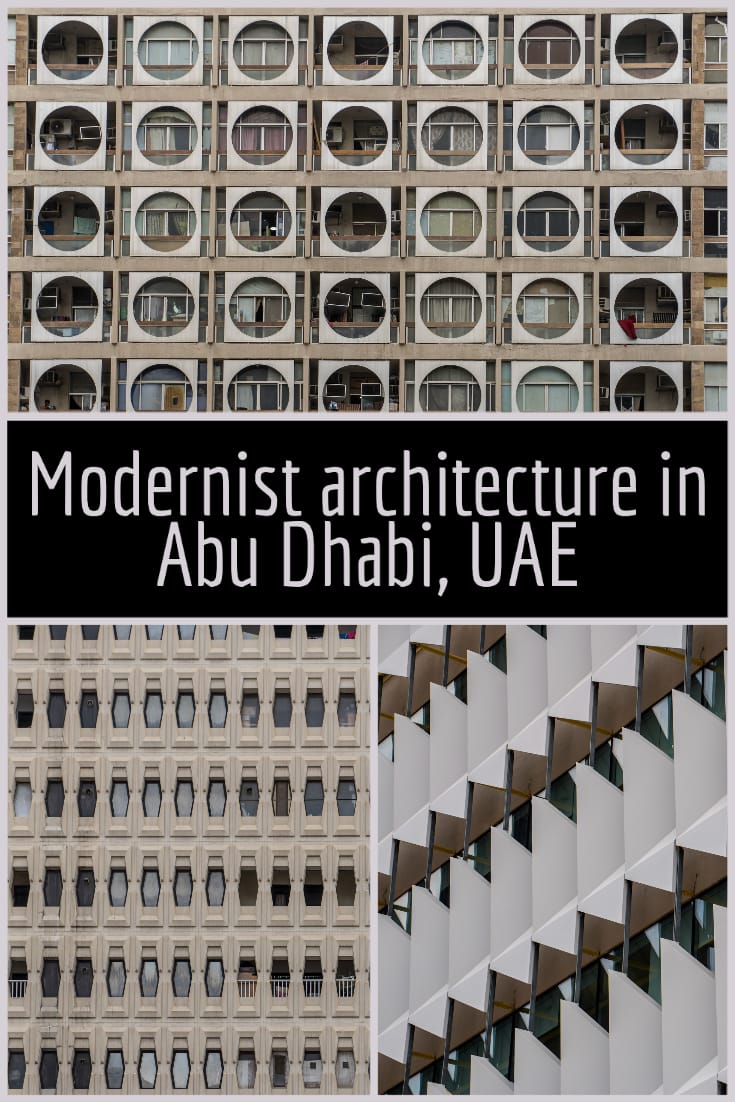
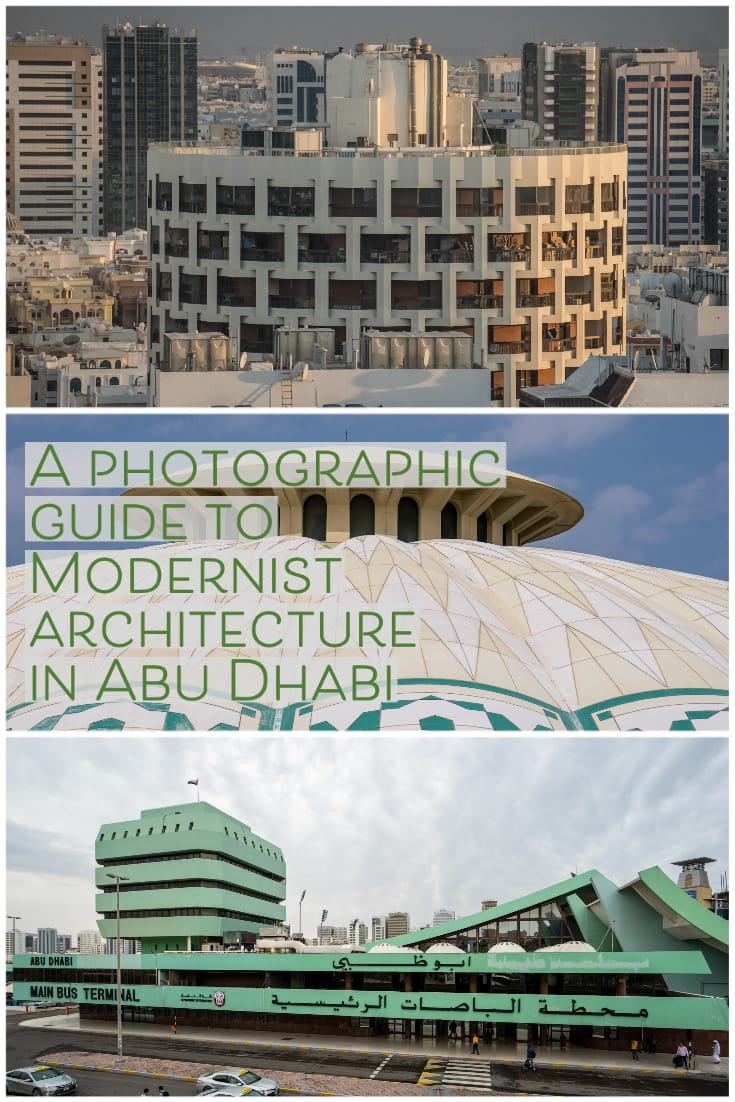
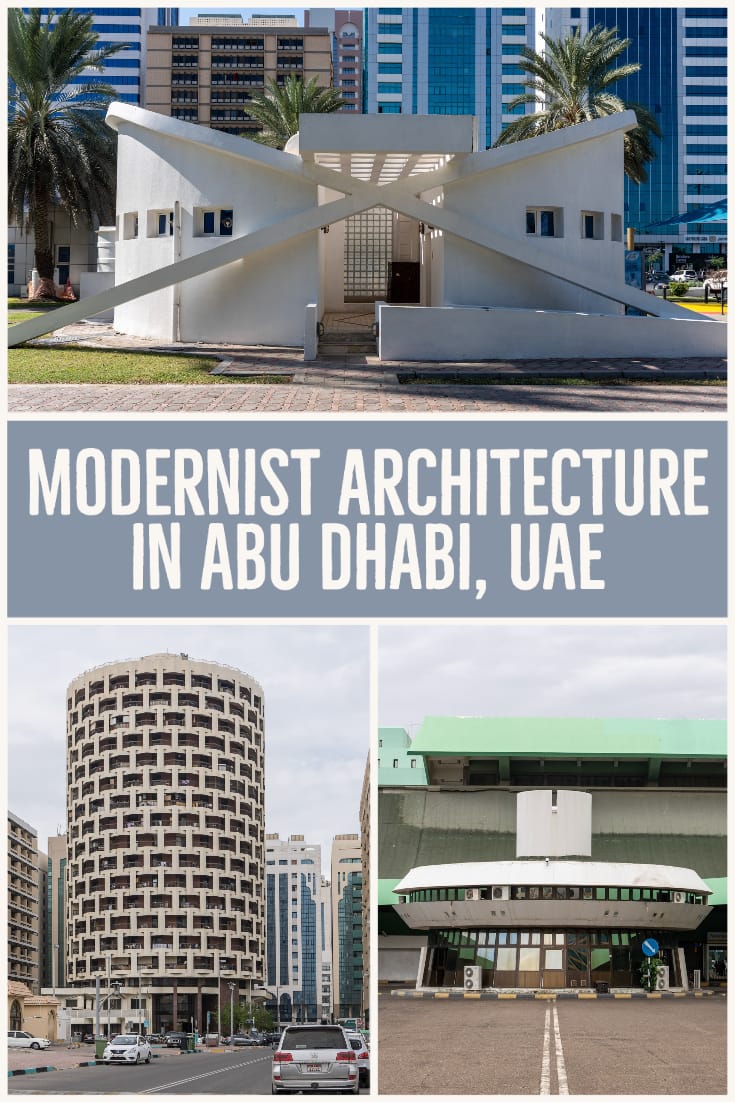

Excellent piece of information especially for people who just came here few years ago.
I have a collection of photos of Abudhabi city that I shot in the 70s and 80s and then 40year later for comparison.
Thank you for your kind words and I’m glad the article has been useful for you. It would be fascinating to see your archive photos – if they are in the public domain and you are happy to share the link, I would be interested to see them!
Thanks for this cool collection! I am an Iranian architecture student in Italy and while searching for the subject of modern architecture in the Middle east popped into this page!
Hello Reza, thank you for commenting, and it’s good to know our post comes up when searching for modern architecture in the Middle East!
I share this article with everyone I know, thanks so much for putting it together. In my year here, I’ve visited about half the buildings listed and am excited to see the rest. Btw the taxi stand IS still there, I was mistaken when I mentioned it before !
Thank you for your kind words and for sharing this article! Glad it gives you an opportunity to see more of the city’s interesting architecture and it’s good to know that the taxi stand is still in situ. Any updates about the status of the buildings featured would be most welcome after your future explorations.
Such a brilliant and informative article. How can I get in touch with the author?
Thank you. We are the authors. You can contact us via our form;
https://www.kathmanduandbeyond.com/contact/
What an amazing collection of images with information provided, thank you very much!
You are welcome. Thank you for reading and the compliment